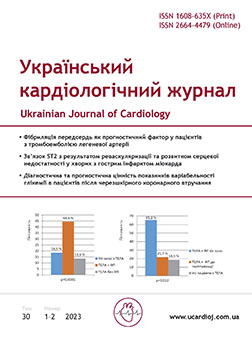Diagnostic and prognostic value of glycemic variability in patients with obstructive coronary artery disease after percutaneous coronary intervention
Main Article Content
Abstract
The aim – assessment of the diagnostic and prognostic value of glycemic variability indicators in patients with coronary artery disease (CAD) after percutaneous coronary intervention followed by optimal drug therapy.
Materials and methods. 121 patients with impaired glucose metabolism took part in the study, who, depending on the presence of CAD, were divided into two groups: group I (n=65) – CAD (+), group II (n=56) – CAD (-). Glucose variability was determined using a continuous glucose monitoring system for 6 days before the start of the study. The method of choice for coronary artery revascularization was percutaneous coronary intervention followed by optimal drug therapy. The results of the study were evaluated by the presence of clinical manifestations of the progression of coronary heart disease and the development of acute cardiovascular events in patients.
Results and discussion. Distribution of patients by gender, bad habits and most concomitant diseases, both groups were comparable, the average age of patients was 54.2 years. With comparable initial values of glycated hemoglobin (7.3±0.9 % vs 7.5±1.2 %, p=0.29), the indicators of glycemia variability were significantly higher in patients with coronary artery disease (mean glucose 8.6±2.1 vs 7.5±1.9 mmol/L; p<0.05). During the observation period (2 years), 20 patients (16.5 %), of which 17 (14.1 %) had a history of CHD and 3 (2.5 %) without a previous diagnosis of CHD, had clinical signs of progression of this disease. 7 (5.8 %) patients developed an acute coronary syndrome, among which 3 (2.5 %) had unstable angina, 3 (2.5 %) had an acute non-Q myocardial infarction, and 1 (0.8 %) had an acute Q-myocardial infarction. When comparing the frequency of development and assessing the relative risk of progression of clinical symptoms of CAD and the development of acute cardiovascular events, the most significant factors were the percentage of time below the target range of glycemia < 3.9 mmol/l more than 5 % per day and SD above 2.
Conclusion. Increased glycemic variability (SD > 2 mmol/L) and period of hypoglycemia < 3.9 mmol/L more than 3 % per day are negatively associated with clinical progression of CAD and the development of recurrent acute cardiovascular events in middle-aged patients with concomitant diabetes mellitus after percutaneous coronary intervention followed by optimal drug therapy.
Article Details
Keywords:
References
Baena-Díez J, Peñafiel J, Subirana I, Ramos R, Elosua R, Marín-Ibañez A, Guembe M, Rigo F, Tormo-Díaz M, Moreno-Iribas C, Cabré J, Segura A, García-Lareo M, Cámara A, Lapetra J, Quesada M, Marrugat J, Medrano M, Berjón J, Frontera G, Gavrila D, Barricarte A, Basora J, García JM, Pavone NC, Lora-Pablos D, Mayoral E, Franch J, Mata M, Castell C, Frances A, Grau M, on behalf of the FRESCO Investigators; Risk of cause-specific death in individuals with diabetes: A competing risks analysis. Diabetes Care. 2016;39(11):1987-95. https://doi.org/10.2337/dc16-0614.
Battelino T, Danne T, Bergenstal RM, Amiel SA, Beck R, Biester T, Bosi E, Buckingham BA, Cefalu WT, Close KL, Cobelli C, Dassau E, DeVries JH, Donaghue KC, Dovc K, Doyle FJ 3rd, Garg S, Grunberger G, Heller S, Heinemann L, Hirsch IB, Hovorka R, Jia W, Kordonouri O, Kovatchev B, Kowalski A, Laffel L, Levine B, Mayorov A, Mathieu C, Murphy HR, Nimri R, Nørgaard K, Parkin CG, Renard E, Rodbard D, Saboo B, Schatz D, Stoner K, Urakami T, Weinzimer SA, Phillip M. Clinical targets for continuous glucose monitoring data interpretation: Recommendations From the International Consensus on Time in Range. Diabetes Care. 2019;42(8):1593-603. doi: https://doi.org/10.2337/dci19-0028. Epub 2019 Jun 8. PMID: 31177185; PMCID: PMC6973648.
Gerbaud E, Darier R, Montaudon M, Beauvieux MC, Coffin-Boutreux C, Coste P, Douard H, Ouattara A, Catargi B. Glycemic variability is a powerful independent predictive factor of midterm major adverse cardiac events in patients with diabetes with acute coronary syndrome. Diabetes Care. 2019;42(4): 674–81. https://doi.org/10.2337/dc18-2047.
Kannel WB, McGee DL: Diabetes and glucose tolerance as risk factors for cardiovascular disease: the Framingham study. Diabetes Care. 1979;2:120–6. DOI: https://doi.org/10.2337/diacare.2.2.120.
Kuroda M, Shinke T, Sakaguchi K, Otake H, Takaya T, Hirota Y, Sugiyama D, Nakagawa M, Hariki H, Inoue T, Osue T, Taniguchi Y, Iwasaki M, Nishio R, Kinutani H, Konishi A, Hiranuma N, Takahashi H, Terashita D, Hirata KI. Effect of daily glucose fluctuation on coronary plaque vulnerability in patients pre-treated with lipid-lowering therapy: a prospective observational study. JACC. 2016;8(6):800–11. https://doi.org/10.1016/j.jcin.2014.11.025.
Monnier L, Colette C, Owens DR. The application of simple metrics in the assessment of glycaemic variability. Diabetes & metabolism. 2016;44(4):313–9. https://doi.org/10.1016/j.diabet.2018.02.008.
Monnier L, Mas E, Ginet C, Michel F, Villon L, Cristol JP, Colette C. Activation of oxidative stress by acute glucose fluctuations compared with sustained chronic hyperglycemia in patients with type 2 diabetes. J Amer Med Assoc. 2016;295(14):1681–7. https://doi.org/10.1001/jama.295.14.1681.
Otowa-Suematsu N, Sakaguchi K, Komada H. Comparison of the relationship between multiple parameters of glycemic variability and coronary plaque vulnerability assessed by virtual histology-intravascular ultrasound. J Diabetes Investig. 2018;9:610–5. doi: https://doi.org/10.1111/jdi.12750.
Stamler J, Vaccaro O, Neaton JD, Wentworth D. Diabetes, other risk factors, and 12-year cardiovascular mortality for men screened in the Multiple Risk Factor Intervention Trial. Diabetes Care. 1993;16(2):434-44. DOI: https://doi.org/10.2337/diacare.16.2.434.
Yang HK, Kang B, Lee SH, Yoon KH, Hwang BH, Chang K, Han K, Kang G, Cho JH. Association between hemoglobin A1c variability and subclinical coronary atherosclerosis in subjects with type 2 diabetes. J diabetes and its complications. 2015;29(6):776–82. https://doi.org/10.1016/j.jdiacomp.2015.04.008.
Zoungas S, Arima H, Gerstein HC, Holman RR, Woodward M, Reaven P. Effects of intensive glucose control on microvascular outcomes in patients with type 2 diabetes: a meta-analysis of individual participant data from randomised controlled trials. Lancet Diabetes Endocrinology. 2017;5:431–7.

